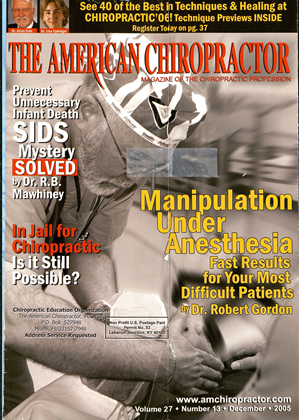D OCTORS OF CHIROPRACTIC HAVE ALWAYS BEEN INTERF.STED IN returning patients to normal function rapidly. Historically. DCs have avoided bed rest, immobilization, and extended time off work. Our approach is supported by most of the recent research on neck and back problems and injuries, which emphasize the benefits of active treatments. One of the major difficulties with rec- ommending active exercises is compliance—the active approach is effective only if the patient actually performs the exercise and/or stretching procedures. The following are a few of the fac- tors I have found to be useful in encouraging this active approach in patients (who often do not want to put a lot of work into getting themselves better). Pre-Printed Exercise Sheets While these are commonly available, the likeli- iioou mai a paueni win uo me exercises correctly, and do them more than just a couple of times is quite slim. I've found that patients tend to invest their energy in proportion to the effort expended by their doctor. For instance: • A printed handout sheet of generic exercises—it's very unlikely that they will be performed more than once or twice. • A printed sheet or CD-ROM of a customized series of exercises—a patient realizes the doctor has put in some thought and effort, and they are more likely to be done at least a few times. • Discussion of the exercises and their importance—the exercises may be done a few more times following supplementary education. • Demonstration of the exercises, with observation and correction of the patient's performance of each one—this provides a much greater chance of the patient's performing them several times. And then, it is only with several follow-ups and some additional supervision that any real compliance with home exercises can be expected. Support and praise from the doctor, as well as the expectation that there will be a recheck will go a long way toward encouraging the patient's cooperation in performing the recommended exercises. Exercises on the Floor It has been my experience that most people resist doing exercises that require them to lie down on their floor. The exception to this is during the early stages of an acute episode (and even then getting down and then back up from the floor can be quite difficult). In spite of this, I still see many doctors and therapists recommending floor-based exercises. We must remember that lying down is not a very important functional Dosition for use of the neck and back; therefore, it is not really the best place to be exercising. I have found much better acceptance (and also better results) when patients are instructed to exercise in a weight-bearing, up- right position. This requires postural awareness while the exercises stimulate and coordinate the proprioceptive control of the involved spinal support muscles. Axial vs. Extremity Exercises I'm continually amazed at the amount of time some patients spend doing exercises with their extremities, when their problem is primarily weakness of the muscles of the axial skeleton. It is the axial skeletal muscles which stabilize, support, and move the spine. Especially in the early stages of rehabilitation, it's very important to establish good strength and coor- dination of the core muscles around the spine and pelvis. Remember that most patients have a limited tolerance for exercising, and a limited amount of time they can devote to them. The focus should be, therefore, on the stabilization of the spinal support musculature initially. It is only later that attention can be directed to a general, overall body strengthening program. Yet, I frequently see back exercise programs that include quadriceps and pectoral muscle strengthening exercises, right from the beginning. Conclusion Doctors of chiropractic are in an excellent position to design and monitor active exercise procedures. With some thought and planning, it is not difficult to integrate an effective spinal rehab program into most chiropractic practices. Getting patients to adhere to active treatment recommendations will always be a challenge; I hope the concepts I've presented are helpful. Hyland, D.C., M.P.H., D.A.C.B.R., D.A.B.C.O., C.S.C.S., C.H.E.S., is board-certified in two chiropractic specialties, and is also certified as a Strength and Conditioning Specialist and a Health Education Specialist. He has 20 years of clinical practice; for eight years he specialized in chiro- practic rehabilitation. He is currently a Research Associate at Parker College of Chiropractic, and an Adjunct Professor of Clinical Sciences at the University of Bridgeport s College of Chiropractic. You can contact him at drjkhvland(w,msn.com\
 View Full Issue
View Full Issue






